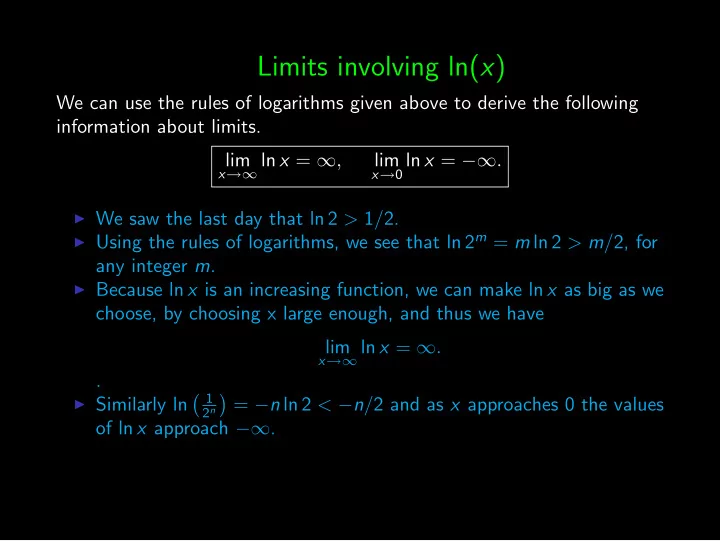

Limits involving ln( x ) We can use the rules of logarithms given above to derive the following information about limits. x →∞ ln x = ∞ , lim x → 0 ln x = −∞ . lim ◮ We saw the last day that ln 2 > 1 / 2. ◮ Using the rules of logarithms, we see that ln 2 m = m ln 2 > m / 2, for any integer m . ◮ Because ln x is an increasing function, we can make ln x as big as we choose, by choosing x large enough, and thus we have x →∞ ln x = ∞ . lim . � 1 ◮ Similarly ln � = − n ln 2 < − n / 2 and as x approaches 0 the values 2 n of ln x approach −∞ .
Example 1 Find the limit lim x →∞ ln( x 2 +1 ). ◮ As x → ∞ , we have 1 x 2 +1 → 0 ◮ Letting u = 1 x 2 +1 , we have 1 x →∞ ln( lim x 2 + 1) = lim u → 0 ln( u ) = −∞ .
Extending the antiderivative of 1 / x We can extend our antiderivative of 1 / x ( the natural logarithm function) to a function with a larger domain by composing ln x with the absolute value function | x | . . We have : � ln x x > 0 ln | x | = ln( − x ) x < 0 This is an even function with graph We have ln | x | is also an antiderivative of 1 / x with a larger domain than ln ( x ). � 1 dx (ln | x | ) = 1 d and x dx = ln | x | + C x
Using Chain Rule for Differentiation dx (ln | x | ) = 1 d dx (ln | g ( x ) | ) = g ′ ( x ) d and g ( x ) x ◮ Example 1: Differentiate ln | sin x | . ◮ Using the chain rule, we have d 1 d dx ln | sin x | = dx sin x (sin x ) ◮ = cos x sin x
Using Chain Rule for Differentiation : Example 2 Differentiate √ 3 ln | x − 1 | . � � ◮ We can simplify this to finding d 1 3 ln | x − 1 | , since dx √ x − 1 | = ln | x − 1 | 1 / 3 ln | 3 ◮ 1 3 ln | x − 1 | = 1 1 1 d d dx ( x − 1) = dx 3 ( x − 1) 3( x − 1)
Using Substitution Reversing our rules of differentiation above, we get: � 1 � g ′ ( x ) x dx = ln | x | + C and g ( x ) dx = ln | g ( x ) | + C x ◮ Example Find the integral � 3 − x 2 dx ◮ Using substitution, we let u = 3 − x 2 . x dx = du du = − 2 x dx , − 2 , ◮ 1 � x � 3 − x 2 dx = − 2( u ) du ◮ = − 1 2 ln | u | + C = − 1 2 ln | 3 − x 2 | + C
Recommend
More recommend